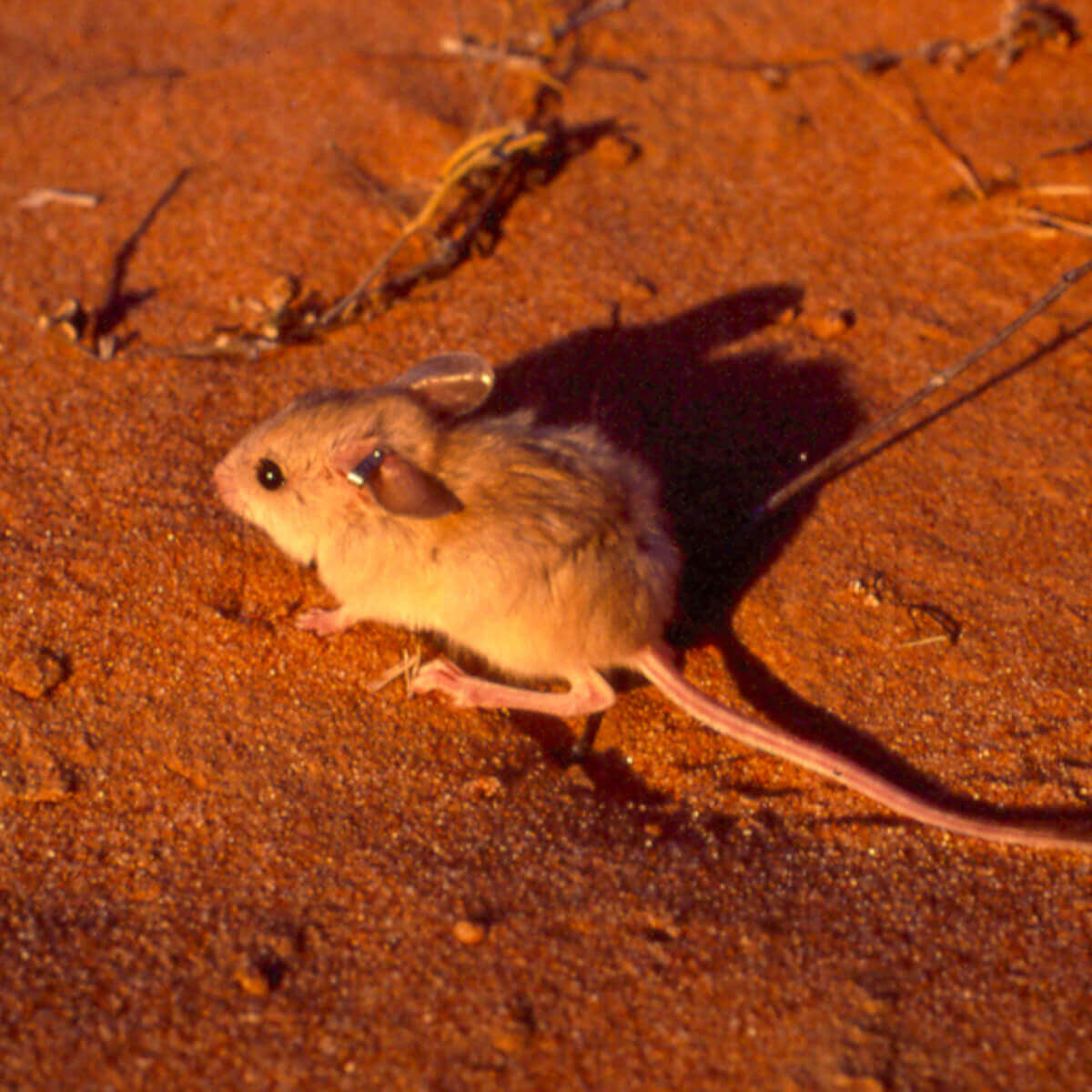Dusky Hopping Mouse (Wilkiniti)
The dusky hopping mouse is a native Australian species that has been becoming increasingly more endangered since European colonisation. “Hopping mice” are actually around ten different types of native mice that all look very similar. But all are from the genus Notomys and are called a hopping mouse in Australia. All are brown-ish in colour and hop on their strong hind legs. The dusky hopping mouse is a specific type found across the arid and desert regions of southern Australia.
The dusky hopping mouse’s characteristics

- Scientific name: Notomys fuscus
- Colour: brown or fawn with a white chest
- Weight: 20 to 50 grams
- Size: 9 to 17 cm, with an even longer tail
- Diet: mainly seeds, but also berries, leaves, green plants and some insects
- Region: small population spread over southern Australia, south-east Western Australia, and the southern parts of the Northern Territory and Central Australia.
You may be able to tell the dusky hopping mouse apart from other Notomys species of mice by its noticeable throat-pouch. This has a fleshy opening surrounded by inward-pointing white hairs. The dusky hopping mouse diet consists largely of seeds as well as berries, green plants, and the occasional insect.
Dusky hopping mouse life-cycle and reproduction
The exact details of the way the dusky hopping mouse lives and reproduces in the wild aren't very well known. It is estimated that they can live to around thirteen months in the wild. However, in captivity, they have been known to live for several years.
During that time, after becoming reproductively mature at around seventy days of age, female dusky hopping mice can reproduce roughly every forty-two days. They have an average litter size of between one and five offspring and can breed for around two years of their life. Males, on the other hand, can breed from around three months of age and can continue to reproduce for around three years.
There is no specific time of year for dusky hopping mouse breeding though, meaning they are polyoestrous. Only the availability of resources and good conditions seems to determine whether they will reproduce or not. In fact, they are often classified as opportunistic breeders, meaning that larger populations can grow and shrink dramatically in size following a change in conditions.
If conditions get bad enough, entire populations may go locally extinct when conditions are very dry and unfavourable. The change between "boom" times of high population density and "bust times" of low has been observed as being as little as two years in one location.
Hopping mouse predators include foxes and cats and they also compete with other animals that were introduced by Europeans following colonisation. Following years of a gradual reduction in numbers, the dusky hopping mouse is now counted as an endangered or vulnerable species.
This means that a lot of care should be taken if you need to have this mice species removed from your property.
The dusky hopping mouse’s habitat
The ideal dusky hopping mouse habitat is sand dunes or grasslands with some shrubs and trees, arid kinds of environments and areas of light woodland where there is at least some sort of hummocks and water nearby. This makes the arid parts of southwest Queensland, northeast South Australia, and western New South Wales an ideal environment for them, though you can find small populations of dusky hopping mice elsewhere.
Where else does a hopping mouse live? Often in desert-like conditions, claypans and gibber flats, although they may only pass through these kinds of regions if they lie within their home range. As a rule, the species is distributed in a fairly broad and disjointed sort of way.
Yet, these mice are well at home in the arid areas they favour. The desert hopping mouse's adaptations to these environments include its powerful hind legs. These can let it jump as far and high as four metres at a time and allow it to have a habitual hopping motion that is a very effective way of conserving energy. They also have highly effective kidneys that allow them to extract maximum value from much of what they consume.
Read more: Rat Life Cycle: Lifespan and Habitat
Dusky hopping mouse facts
- The dusky hopping mouse gets all of its liquid needs from food and does not need to drink water. It has this in common with other hopping mice.
- This kind of native hopping mouse digs a burrow with a single central tunnel around 5 cm in radius about a metre below the surface of, ideally, a sand dune. This burrow will have up to six entrance shafts. These shafts are vertical – the mice dive into them like swimmers to enter!
- The hopping desert mouse, as the dusky hopping mouse is sometimes known, is nocturnal.
- Hopping mouse poop may in fact be solid urine! Some species of hopping mice can concentrate their urine to a far greater degree than humans, getting all of the possible nutrition from what they eat and conserving water in the dry conditions they like to live in.
- The overall population of dusky hopping mice is thought to now be below 10 000.